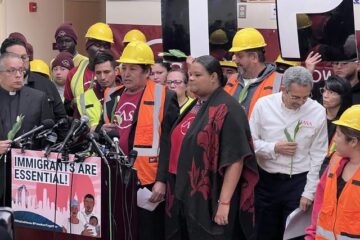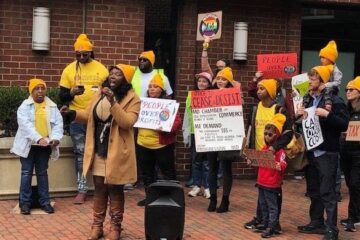Protesters dispersed with tear gas. Photo:Prensa Libre/Guatemala
Only Half of the Story
Guatemala has once again made international headlines. Photos published by major US media showed an angry mob setting fire to the National Congress building in Guatemala City.
The New York Times, in an article entitled “Protesters in Guatemala Set Fire to Congress Building Over Spending Cuts,” wrote, “Thousands of protesters took to the streets in Guatemala’s capital on Saturday, setting fire to the nation’s congressional building in a show of anger over a budget bill passed this week that cut funding for health care and education.”
The real story, however, is far more complex and much more alarming.
The Billion-Dollar Question
With the arrival of Coronavirus in Guatemala, the administration of President Alejandro Giammattei declared a “state of calamity,” which eased restrictions on the government’s ability to seek millions of dollars in emergency loans and donations to fight COVID-19.As the months passed, however, the country did not see a significant improvement in medical attention, equipment, or infrastructure. Instead, hospitals were overrun by COVID-19 patients, testing became irregular, and medical workers complained of a lack of personal protection equipment, unsanitary conditions, and nonpayment of salaries. Doctors and nurses were among the mortal victims of COVID-19. Although 1.9 billion dollars were earmarked for social programs designed to provide a safety net for families during the coronavirus crisis, these programs came up short. An additional Q200 million (roughly $27 million) was designated by the Giammattei administration “for people of limited resources,” yet many poor families were forced to wave white flags, a symbol of need, begging for food by roadsides throughout Guatemala.
Criticism grew against the government for misuse of funds and outright corruption. On social media a growing wave of voices asked, “Where is the money?” and the hashtag #DondeEstaElDinero began to trend.
Recently the government’s deficient response to the suffering and tragedy caused by the back-to-back hurricanes Eta and Iota once again had Guatemalans asking, “Where is the money?”
The outcry was such that Guatemala’s Vice-president, Guillermo Castillo, offered to resign and publicly suggested that the president to quit along with him.

The Budget
On November 18, in the wee hours of the morning, the Guatemalan Congress approved a stunningly bloated budget for 2021. The Q99,000,000,000 budget (roughly $13.2 billion) was the largest in Guatemala’s history. In addition, the Congress approved a loan of $428 million, an amount that would sink the country deeper into debt.
The new budget severely underfunded essential services such as health, education, the environment, and human rights. It also slashed Q200 million—about $27 million—in funding allocated to fight malnutrition in Guatemala; this, in a country where half of the children suffer from chronic malnutrition. Earlier this month local newspapers reported the death of a 9-year-old boy in Jocotán, Guatemala due to chronic malnutrition.
At the same time, members of Congress approved $65,000 for their own meal plans. Guatemalan civil society immediately called for peaceful protests, demanding that the president veto the 2021 budget.
The Protests and the Violence
On the afternoon of November 21 thousands of men, women, and children gathered in front of the National Palace. The police presence was sizeable, but the protestors waved flags, carried banners denouncing the unjust budget, and cried out against corruption. The civil gathering was peaceful, full of creative energy and righteous indignation. It was also an act of protest fully protected by the Guatemalan Constitution and backed by the Human Rights Ombudsman’s office (PDH).
Six blocks away from the organized protest, a group of people gathered in front of the National Congress. Oddly, there was absolutely no police presence to safeguard the installation. At 2:30 PM vandals broke the windows of the building, entered the building, and set fire to the interior. The police did not arrive until much later.
At 3:00 PM President Giammattei tweeted, “I reiterate that one has the right to demonstrate in accordance with the law. But we also cannot allow vandalism of public or private property. Anyone found to have participated in these crimes will be punished with the full force of the law.”
At approximately 5:00 PM riot police arrived at the National Palace. With absolutely no provocation, and no previous warning, they began to shoot canisters of tear gas into the peaceful demonstration. Men and women, children and the elderly, were forced to flee.
The riot police began lashing out indiscriminately at anyone they encountered in the city streets. Photographers, journalists, demonstrators, street vendors, parents and children, church workers, and others were caught in a tide of police brutality: gassed, beaten, and bloodied. A photojournalist had his camera knocked to the ground before receiving repeated baton blows to his head. Women were kicked, thrown, and dragged through the streets by their hair. Two young men lost their left eyes when police fired teargas canisters at head level into the crowd. In total, 31 innocent people were arrested.
Injustice and Justice
Isabel Solis, GHRC’s Guatemala City Office Director, observed the hearings of several of the accused. She reports that one of the charges against many of the 31 of the arrested was «destruction of cultural patrimony,» a charge that falls outside of the jurisdiction of the Justice of the Peace, who otherwise could have released the protesters.
Those accused of this charge, therefore, had to spend at least two nights in prison. After a physically and emotionally exhausting wait, every single person arrested had the charges against them dropped by the presiding judges for “falta de mérito” (a lack of evidence).
Some Doubts that Remain
· The governing board of the Guatemalan Congress has agreed to temporarily “shelve” the 2021 Budget. Yet this unilateral act in itself might be illegal since it doesn’t have the support of the entire Congress.
· National Civil Police officers stated that those arrested had been caught in flagranti, while committing the arson, yet all of the arrests occurred in different locations and hours after the fact.
· Leaked images published on social media showed fire extinguishers and large barrels of water had been set up inside the building previous to the fire.
· The former head of the International Commission Against Impunity in Guatemala (CICIG), Ivan Velazquez, tweeted a question about where the guards were who were supposed to be in front of Congress as it was being burned. «It’s very strange, if not suspicious, that infiltrators could get into and set fire so easily to a building that should have the greatest levels of security,» he wrote.
· Human rights monitors in Guatemala suggest the fire may have been set by government-affiliated elements to create a pretext for repression.
In Conclusion
GHRC is concerned about the mental and physical wellbeing of those who were brutally attacked and falsely arrested by the police. We are also concerned by the increasing use of criminalization by the government to dissuade and discredit legitimate social protest and the defense of human rights. Finally, GHRC joins with those who are calling for a thorough and impartial investigation into the arbitrary arrests and the use of excessive force by agents of the National Civilian Police (PNC) and those in the chain of command who ordered the repression.




